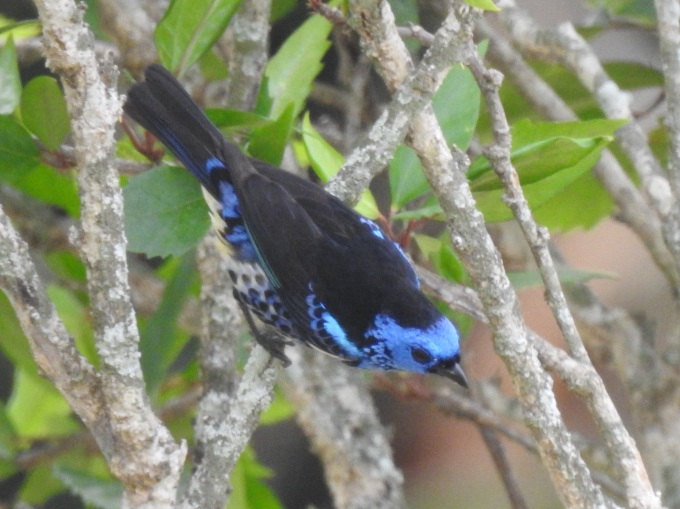We left on March 24 for a 13-day trip to Guyana (formerly British Guiana) in northern South America, slightly north of the equator. This birding tour, run by Field Guides, Inc., was led by Marcelo Barreiros, and co-led by local expert John Christian; they made a very effective team.

Guyana has become a popular birding destination in recent years because of a combination of extensive unspoiled habitat, and slowly emerging infrastructure. As a former British colony, English is spoken throughout. Accommodations away from the coastal and capital city of Georgetown are still pretty rustic, with no air conditioning, power outages at night, limited food choices, cold showers, and plumbing that often does not function properly. However, some of these are locally-owned eco-lodges on beautiful sites. Most are reached via the wide gravel Linden-Lethem Road, which runs 276 miles from near the coast to the Brazilian border. It cuts across massive swaths of forest and savanna on the Guianan Shield, a 1.7-billion year old section of continental crust.

We spent our first real day birding (of ten) along the Mahaica River and at the Georgetown Botanical Gardens. One highlight was seeing a striking Blood-colored Woodpecker well; this species is found only in the Guianas. On Day 2 we flew in a 12-seat turbo-prop to Kaieteur Falls National Park, which is reachable only by air. The falls are said to have the tallest sheer drop in the world, at 741 feet. The thin soil over bedrock near the top of the falls had the most appealing plant community we saw during the trip, with a number of interesting flowers.

It was a thrill here to see Guianan Cock-of-the-Rock at a lek (communal mating grounds). The adult male of this large cotinga (a family of principally neotropical fruit-eating birds) is about as pure an orange as can be found in nature. Frugivores such as cotingas and birds of paradise have a tendency to develop spectacular plumages and mating displays, making them among the most fascinating land birds on the planet.

Over the next eight days we spent two days each based at four lodges along the Linden-Lethem Road. The first two of these were in forest; the third at the interface of forest and natural grassland; and the last in the northwestern portion of the extensive Rupununi Savanna. First up was Iwokrama River Lodge, where I saw my 4000th native bird species, Painted Parakeet! Other highlights here were Lined Forest-Falcon and Red-and-Green Macaw, a stunning and massive parrot. On an owling trip after dark, using the thermal scope, I found a Red-nosed Armored Tree-rat resting on a horizontal branch about 25 feet off the ground, providing an excellent view.

Our second base camp was at Atta Rainforest Lodge, which had great birding on the grounds, where the small clearing (and an aerial walkway) allowed viewing of canopy species. Some favorites here were Black-faced Hawk, Golden-headed Manakin, Painted Tody-Flycatcher, and Guianan Red Howler, a large monkey with spectacular, far-carrying vocalizations.

Our third stay along the Linden-Lethem Road was at Surama Eco-Lodge. In the surrounding areas we found White-naped Xenopsaris, a flycatcher-like bird that was a lovely study in monochrome. While hiking we were surprised to come across a Linnaeus’s Two-toed Sloth, an infrequently encountered mammal, low in a tree and out in the open (they are usually high in the canopy and hidden in vegetation) . It ascended a tree rather quickly (for a sloth), perhaps because we interrupted it during its once-per-week trip down to the forest floor to defecate.

My single favorite experience of the trip was when a Common Potoo was called in using a recording of its vocalization. One flew in and perched in a nearby bare tree, and proceeded to utter repeatedly its mournful song, which I consider one of the most haunting and poignant sounds in the world.

Our last base camp was at the Manari Ranch, close to the border with Brazil (where we went for lunch one day). On the drive there we searched intensively for the mythical Rufous-winged Ground-Cuckoo, which we heard, and for Giant Anteater, which eluded us entirely. Highlights while in the Rupununi Savanna included Hoary-throated Spinetail, Bearded Tachuri, Maguari Stork, and Orange-backed Troupial.

In total, Eileen and I saw 332 species of birds, of which 95 were new to us, a decent haul in just ten days of field work. We saw only 7 species of mammals, of which 3 were new. Many birding tours of necessity go to areas where only small fragments of the original habitat remain; it was a refreshing experience to visit a country with extensive and largely intact ecosystems.

Excellent and inspiring, as always. I looked up the sound of the Common Potoo—it seems it is practicing scales!
LikeLike
Another great trip under your belt!! Glad you are home safe and probably preparing for the next one on the list. We head to N California soon for a week at Clear Lake – looking forward to some different birds from S CA – and a nearly full lake!! Take care, Bob and Connee ________________________________
LikeLike